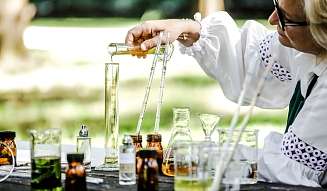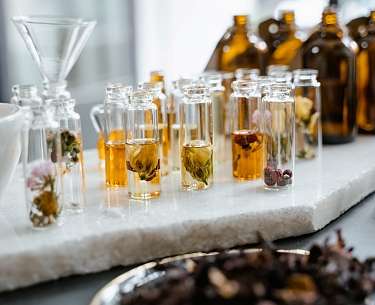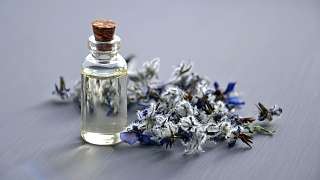Romantik Blog
Interview with Antonella Bondi
What materials do you use to make perfume?
I only use 100% natural and sustainable essences, pure alcohol and water.
What do you teach in your perfume courses?
Participants learn how to connect their emotions with nature and how to increase well-being through the olfactory elements of the essences. They learn to look at themselves in a different way, to translate their personality into a fragrance system.
How do people find the fragrance that matches their personality?
Through a questionnaire that brings out the main characteristics of a person. These include personality aspects and individual preferences for colours, tastes, smells, plants, herbs, spices ... I then use these results to create a tailor-made essence for each individual. With this, one can then make what one wants. At the end of a course, the participants have a perfume, a shampoo or a body lotion created from their own personal scent.
Fragrances and smells are often associated with memories or emotions. What exactly happens there?
Fragrances are physically perceived, arrive directly in the brain and memory centre and thus establish an immediate connection from the outside to our inside. They represent a connection with the earth and our eternal need for a place to connect with it and nature.
Is there an example of this from your personal environment?
When I was a child, everything in my family's garden exuded its scent - from herbs like rosemary, sage, mint and basil to fruits like lemons, tangerines, oranges, cherries, raspberries and strawberries. My fragrances strive to recreate this experience. A journey into the past or a glimpse into the future, an exploration of what is real.
To what extent are fragrances and perfumes also an expression of your own personality?
Every perfume takes you into a world of its own, formed from memories, smells, feelings and sensations. This mixture is extremely personal. I am convinced that in addition to a physical identity, we should also have an olfactory identity.

Magic mixture
With his world bestseller "Perfume" (1985), author Patrick Süskind takes readers into the magical realm of fragrances with all its secrets and temptations. Despite infinite variations in blending and production, most perfumes are composed of three notes:
The top note
is the first thing people perceive. It forms the first impression and often influences the decision to buy. Its scent is intense, but also dissipates quickly.
The heart note
forms the actual character of the perfume. It asserts itself after the top note has dissipated. The heart note contains most of the floral nuances, which are combined with other aromas.
The base note
is the final note of the fragrance and contains long-lasting components. It can still be smelled on the skin for several days.

Fragrances
Million-dollar bottle
The most expensive perfume in the world is called "Shumukh" and comes from the luxury label Nabeel from Dubai. The 3-litre flacon costs 1.143 million euros, but is also decorated with 3,571 diamonds, gold, silver and topaz.
Timeless lace
On the market since 1921 and still regularly in the top ten best-selling perfumes in the world - Chanel No. 5 is the number one fragrance. According to a Chanel estimate, a bottle of the classic is sold every 30 seconds worldwide.
Royal origins
The Egyptian pharaoh Hatshepsut (1490 - 1469 BC) is said to have been the first to use perfume during her lifetime. Before that, perfume mixtures were only offered to gods or the dead.
The healing power of fragrances
Fragrances can be beguiling, soothing and can also be used specifically as a remedy. Aromatherapy uses their manifold effects for the treatment of physical and mental complaints.
The effect of scents has been known in naturopathy for several thousand years. As far back as ancient China, India and Egypt, medical practitioners relied on the healing powers of plant oils. Today, alternative practitioners, doctors, midwives, physiotherapists and psychotherapists rely on the positive effects of aromatherapy. Only 100 percent pure essential oils are used as highly concentrated plant essences, which are obtained by steam distillation, peel pressing or extraction.
Cell biologists attest essential oils a therapeutic effect. When the essences are inhaled, scent particles reach the limbic system, the emotional centre of the brain, via the olfactory cells in the form of impulses. There they have an effect on feelings, can influence well-being or relieve anxiety and tension. In addition to diffusion through the air, the oils can also act through the skin and are applied especially for headaches, nausea or tension. The ingredients enter the bloodstream and unfold their effect there. For inhalation, essential oils are mainly used for respiratory complaints. Most scented oils can be used in several ways. For example, lavender has a calming and sleep-promoting effect in the air of a room, and when massaged into the forehead and temples it helps with headaches. There are about 2300 plant species worldwide from which essential oils can be extracted - 2300 ways to do something good for body and soul.
Small scent lexicon
This is how the essential oils work on the mood and on physical complaints.
Bergamot
In the air: invigorating, refreshing, mood-lifting
On the skin: for cramps
Jasmine
In the air: euphoric, invigorating, balancing
On the skin: for dry, irritated skin
Lavender
In the air: calming, relaxing, balancing
On the skin: for headaches, insomnia, itching, burns
Mint
In the air: refreshing, nervine, mentally stimulating On the skin: for headaches
Orange
In the air: nervine, refreshing, mood-lifting.
On the skin: for cellulite
Patchouli
In the air: stimulating, aphrodisiac.
On the skin: for inflamed skin
Rose
In the air: aphrodisiac, soothing, balancing
On the skin: for heart problems, girdle roses, herpes
Post your comment
Comments
No one has commented on this page yet.
RSS feed for comments on this page RSS feed for all comments



